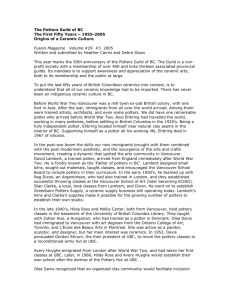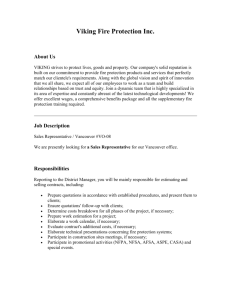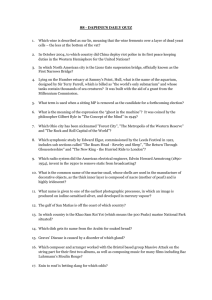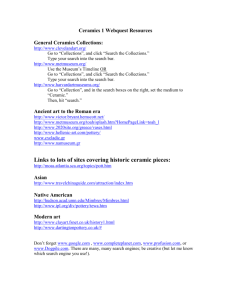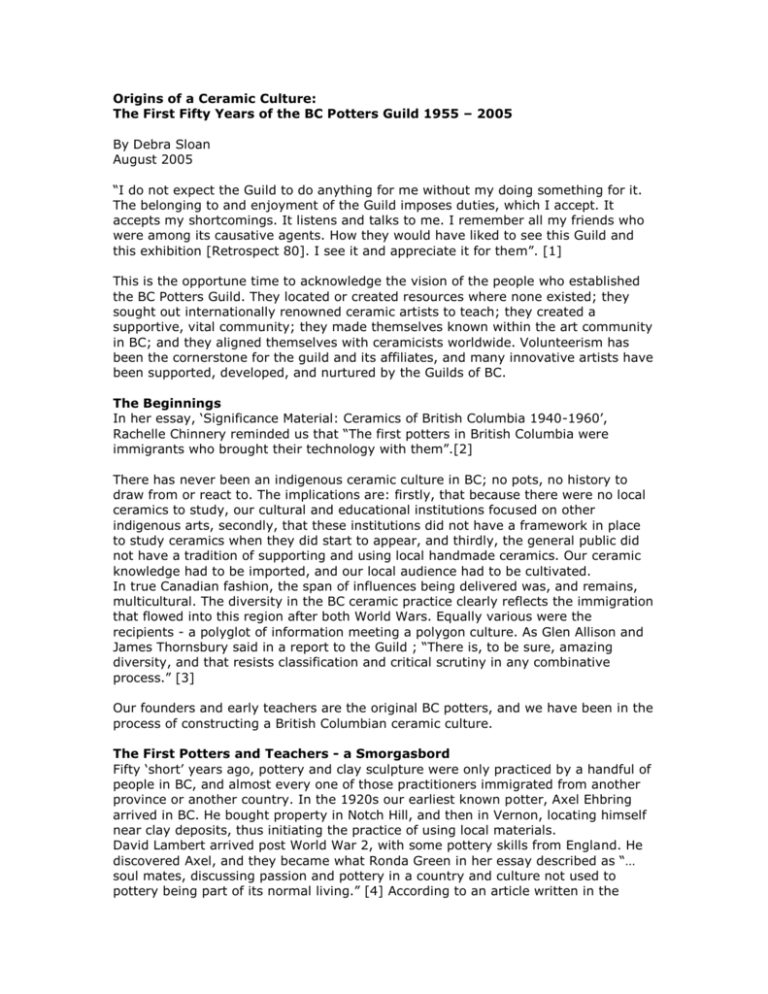
Origins of a Ceramic Culture:
The First Fifty Years of the BC Potters Guild 1955 – 2005
By Debra Sloan
August 2005
“I do not expect the Guild to do anything for me without my doing something for it.
The belonging to and enjoyment of the Guild imposes duties, which I accept. It
accepts my shortcomings. It listens and talks to me. I remember all my friends who
were among its causative agents. How they would have liked to see this Guild and
this exhibition [Retrospect 80]. I see it and appreciate it for them”. [1]
This is the opportune time to acknowledge the vision of the people who established
the BC Potters Guild. They located or created resources where none existed; they
sought out internationally renowned ceramic artists to teach; they created a
supportive, vital community; they made themselves known within the art community
in BC; and they aligned themselves with ceramicists worldwide. Volunteerism has
been the cornerstone for the guild and its affiliates, and many innovative artists have
been supported, developed, and nurtured by the Guilds of BC.
The Beginnings
In her essay, ‘Significance Material: Ceramics of British Columbia 1940-1960’,
Rachelle Chinnery reminded us that “The first potters in British Columbia were
immigrants who brought their technology with them”.[2]
There has never been an indigenous ceramic culture in BC; no pots, no history to
draw from or react to. The implications are: firstly, that because there were no local
ceramics to study, our cultural and educational institutions focused on other
indigenous arts, secondly, that these institutions did not have a framework in place
to study ceramics when they did start to appear, and thirdly, the general public did
not have a tradition of supporting and using local handmade ceramics. Our ceramic
knowledge had to be imported, and our local audience had to be cultivated.
In true Canadian fashion, the span of influences being delivered was, and remains,
multicultural. The diversity in the BC ceramic practice clearly reflects the immigration
that flowed into this region after both World Wars. Equally various were the
recipients - a polyglot of information meeting a polygon culture. As Glen Allison and
James Thornsbury said in a report to the Guild ; “There is, to be sure, amazing
diversity, and that resists classification and critical scrutiny in any combinative
process.” [3]
Our founders and early teachers are the original BC potters, and we have been in the
process of constructing a British Columbian ceramic culture.
The First Potters and Teachers - a Smorgasbord
Fifty ‘short’ years ago, pottery and clay sculpture were only practiced by a handful of
people in BC, and almost every one of those practitioners immigrated from another
province or another country. In the 1920s our earliest known potter, Axel Ehbring
arrived in BC. He bought property in Notch Hill, and then in Vernon, locating himself
near clay deposits, thus initiating the practice of using local materials.
David Lambert arrived post World War 2, with some pottery skills from England. He
discovered Axel, and they became what Ronda Green in her essay described as “…
soul mates, discussing passion and pottery in a country and culture not used to
pottery being part of its normal living.” [4] According to an article written in the
Western Potter by David Lambert, in February 1967, no one was sure exactly where
Axel had come from, whether it was Denmark or Sweden. But David was sure that
Axel had traveled all over the world and had trained in many places. He was
convinced that Axel was a sophisticated artist who for reasons unknown ended up in
BC. Axel found and made all of his own materials and tools, persisting with his craft,
and selling across North America until his death from silicosis in 1954.
David Lambert worked with the Vancouver School Board to establish pottery classes
within the school system. He ran a studio, a school, a supply store, and designed
small kilns. He employed people to produce a line of pottery that sold across Canada,
his famous stickman series, and he was a poet. He worked well into his old age,
repairing school kilns around the city. David Lambert is fondly known as the ‘Father
of pottery in BC’.
David also teamed up with Reg Dixon, an Argentinean, who had studied in London
for his Biology Major, before arriving in Vancouver. Reg declared himself a selftaught potter. In the very early 1950s David and Reg took over the small ceramics
department at the Vancouver School of Art, and established successful wheel
throwing classes. Reg Dixon taught at the VAS from 1954-1957 and later from 19671975.
During the summers Reg Dixon traveled around BC in a station wagon, with kiln and
wheel, looking for raw materials and teaching in small communities. It was during
one of those sojourns, in the later 1950s, that Louise Bowman Schwenk took a class
from Reg Dixon in Penticton. The next year she attended the Vancouver School of Art
with her husband, Adolf Schwenk, a painter. He had emigrated from Germany in
1929, walking from Calgary to the coast, looking for a perfect place to settle. He met
his future wife along the way. After training at the VAS, Louise and Adolf took their
expertise back to their log cabin near Penticton. Making use of the local Okanagan
clay they proceeded to build up a very successful pottery. Louise was the thrower
and Adolf was the painter. Their work was exhibited across Canada and garnered
recognition and many awards. In 1966 they were awarded a year of study in Europe,
by the Canada Arts Council, a Senior Craftsman Fellowship. Louise tragically passed
away while visiting the Leach pottery. Adolf traveled on alone and sent reports back
to the BC Potters Guild. Frances Hatfield worked with Adolf in Penticton till just
before his death in 1968.
Stan Clarke was an early student of David Lambert and Reg Dixon. David Lambert
was so often away from his store that Stan decided to get involved in locating and
supplying materials. In the early 1960s he established ‘Greenbarn’, a ceramic supply
company, which along with Lambert’s kilns, was instrumental in sustaining a growing
amateur community. As well as running Greenbarn, Stan, an enquiring soul, and his
daughter, Christie, experimented with blown glass. Still active at 91, he works one
day a week at Greenbarn and is trying his hand as a wood-turner.
In 1957 Robert Weghsteen, who had trained in Belgium and London, traveled to
Vancouver. He brought his entire workshop; a wheel, a giant electric kiln, and
supplies, through the Panama Canal. He knew that the ceramic practice was so new
to BC that he would be wise to bring as much as he could. Robert was very
interested in using local clays and did substantial research of the clays found in the
Quesnel region. Robert developed a broader ceramic course of study at the
Vancouver School of Art.
This programme proved to be the foundation for an influential series of teachers at
the Vancouver Art School [now the Emily Carr Institute of Art and Design]. Some of
these have been and are: David Lambert, Reg Dixon, Robert Weghsteen, Stan
Clarke, Leonard Epp, Don Hutchinson, Hiro Urakami, Heinz Laffin, Wayne Ngan, John
Reeve, Tam Irving, Sally Michener, and presently Linda Sormin, and Paul Mathieu.
Robert left teaching at the VAS and moved to Langley. He went on to support his
family through making murals for private and public buildings across Canada. His
wife Joanne, a print maker and painter, was instrumental in helping him market his
work, and Don Hutchinson was an assistant on a number of Robert’s larger
commissions. Robert Weghsteen is another of our founding potters who has
sustained his ceramic practice, now working at the Delta Potters Guild, and has a
piece in the 2005 - Fiftieth Anniversary exhibition “TransFormations”. Acquiring
supplies and materials was a challenge in the early decades.
Most of the trained ceramicists who came to BC were keen to find clay sources. In
1958 Olea Davis, Reg Dixon, Stan Clarke, and Hilda Ross were given a grant by the
Leon and Thea Koerner Foundation to conduct a report on BC clays for the UBC
Extension Department. They were particularly impressed with stonewares from
Quesnel, as was Weghsteen, but also tested lo-fire clays from Bear Creek, Langely,
Parksville, Kelowna, Mission, and Haney. Most of the early potters used raw
materials. The early teachers at UBC and the VAS, Reg Dixon, Rex Mason, Robert
Weghsteen, Don Hutchinson, Tam Irving, and Leonard Epp, all promoted the use of
local raw materials. The early potters connected with brick companies in BC and
Alberta to have clays formulated. Finding and altering raw materials remains a
fascination with many potters. In Quadra, Martha and Gordon James prepare a local
clay, Don Hutchinson uses local clays for slips, as do many potters, and Tam Irving
has raised the practice to an art form with his glazes painstakingly made of materials
found from all over the province.
In the late 1940s, there were classes being held in several locations in Vancouver.
Hilda Ross and Molly Carter taught classes at Gordon House, in the West End. David
Lambert, and Jean and Stan Clarke were holding classes in their studios in
Vancouver. In 1948 Mollie Carter, Hilda Ross, and Zoltan Kiss started teaching out at
UBC, taking over the ceramic classes in the old Fine Arts Gallery in the basement of
the library. These classes were sponsored by the I.O.D.E. [the Independent Order of
the Daughters of the Empire]. Zoltan Kiss, a Hungarian, had trained as a potter in
Denmark. He found it difficult to make a living as a potter, so he retrained in
architecture. Zoltan had a very successful career as an architect, but he has also
maintained his ceramic practice and has been selling at a gallery in West Vancouver.
Olea Davis, who came to Vancouver from Ontario, with degrees from the Ontario
School of Art, and L’Ecole des Beaux Arts in Montreal, persuaded Gordon Shrumm,
the UBC President, to support an enlarged ceramic programme at UBC. In 1950, the
classes were then moved to a reconditioned Army Hut in the Acadia Camp [which
became known as the UBC Ceramic Hut or the Pottery Hut.
By 1952 the UBC Extension Department took over the management of the classes.
Olea taught and organized the classes for 13 years along with Tommy Kakinuma,
from the USA, Santo Mignosa, a clay sculptor from Sicily, and later Rex Mason, from
the USA, and John Reeve, from Vancouver. In addition to the regular classes, from
the early fifties through the sixties, the Extension Department and the Vancouver
School of Art sponsored and brought in many internationally renowned teachers.
Some of these were: Edith Heath from California, Alexander Archipenko from New
York, Olivier Strebelle from Belgium, Carlton Ball from the University of Illinois,
Kyllikki Salmenhaara from Finland, and Marguerite Wildenheim via USA, but trained
also in Germany, Harry Davis from New Zealand [many times] and Michael Cardew
from England. Every artist brought a different range of ideas, techniques, and
philosophies.
In the 1960s, at the UBC Faculties of Education and Fine Arts, taught by Glenn
Lewis, two other significant ceramic artists were receiving an art education: Gathie
Falk and Charmian Johnson. They later worked with Mick Henry up at Roberts Creek.
Gathie went on to make some of the most significant clay sculpture in BC, and
Charmian is known and regarded for her serene, elegant pots. Charmian instigated
the successful 2004 exhibition held at the UBC Belkin Gallery, “Thrown”.
During the early years, the Vancouver Art School, the UBC Pottery Hut, and UBC Arts
Department each had a radius of influence and were quite distinct from each other.
These ceramicists were aware, as Santo Mignosa wrote in the Western Potter in 1967
“We do not have a tradition; we are the tradition on which our followers must build.”
At present there are twenty-one colleges around BC and countless community
centres with excellent ceramic programmes. Over the last 20 years the Vancouver
Art School evolved into a college, and is now the Emily Carr Institute of Art & Design,
a degree granting institute. It is currently developing a postgraduate programme.
This is a far cry from the 1950s, when the little groups at UBC and at the VAS, were
trying to find the ways and means to supply and teach ceramics.
Founding the Potters Guild of BC
During the late 1940s and 1950s, Olea Davis was a practicing designer, painter,
ceramicist, and sculptor and was active in the post-modernist Vancouver arts scene.
This was a close-knit arts community with an internal dialogue. This era was depicted
in the 2004 exhibition “A Modern Life” at the Vancouver Art Gallery. Many of the
local architects, painters, furniture makers, sculptors, and some ceramicists were
represented.
In 1949 Olea had visited potters in Ontario and saw the effectiveness of the
Canadian Guild of Potters. She recognized that an organized clay community would
facilitate inclusion into the larger art scene in Vancouver. So Olea Davis, Hilda Ross,
Avery Huyghe, and Stan Clarke decided to establish a Guild.
By 1955 the BC Potters Guild was founded. Olea was president, Stan Clarke was
vice-president, Avery Huyghe -treasurer, Reg Dixon and Rex Mason were
consultants. Olea’s vision went beyond promoting ceramics in Vancouver and BC, she
affiliated our Guild with the Canadian Federation of Artists, the Canadian Guild of
Potters, and the American Craftsman Council. In 1963 Olea was in discussions with
Luke Lindoe about establishing a Western Potters Association. Walter Dexter, Jack
Sures, and Marilyn Levine, all from Alberta, were on the committee. In 1964 Olea
was one of three Canadians representing Canada at the World Craft Council. With
Olea’s encouragement, many of the PGBC members successfully exhibited locally and
nationally. In 1962 Hilda Ross was a gold medal winner in an international exhibition
in Prague. The Schwenks, Santo Mignosa, David Lambert, Avery Huyghe, Olea, and
many others received national recognition during the 1960s. In 1970, Santo was
invited to represent Canada at the International Academy of Ceramics.
The aesthetic interaction between the different art practices that was so effective
during the Post Modernist era is not as apparent today. Vancouver was then,
physically and metaphysically, removed from the rest of the world. These artists
were reliant on each other. In fifty years Vancouver has more than tripled in size,
communications have experienced a metamorphosis, and now there is a myriad of
art practices. It is no longer necessary to use a common voice to be heard.
The very geographical nature of BC has made it difficult to maintain contact with the
distant members. It became a tradition of the PGBC and affiliated guilds to invite
ceramicists to present their workshops around BC. During the late 1970s to mid
1980s, the PGBC established the Traveling Workshops, and the Vancouver School of
Art had an Outreach programme where students were sent out to run workshops. If
you read the histories of the affiliated guilds, it is apparent the benefits to all were
twofold; potters outside of the lower mainland were able to attend workshops, and
these workshops created job opportunities for those ceramicists willing to travel.
The most important way of maintaining contact with the membership for 50 years
has been the newsletter. It started out as a quarterly, “the Western Potter”. During
the early years this was the primary method of communication, before cheap long
distance telephone and email. The Guild started as a how-to association, as books on
ceramics were rare. Articles were lengthy, and technical information was highly
valued. Biographical articles were popular, and there were discussions on the value
of juried shows, volunteer help, and the function of the Guild, as there are today.
Our newsletter is no less important for the membership now. It still serves to link us
across the province. We now have additional email and website services.
At this juncture in the essay, it is apparent that the point of contact for most of the
early teaching, and the early studios, was in Vancouver. However, as time went on,
many potters left the city. For those who read Leach’s book “A Potters Life”, pursuing
the promised life-style meant establishing a production pottery on an acreage somewhere remote enough to be cheap, but near a highway or tourist destination for
sales. Wayne Nygan, probably the most familiar name of all BC potters, set his
studio up on Hornby Island in the early 1970’s, and has achieved remarkable success
‘for a potter’ in Canada. He has been the subject several NFBC films, and his studio
has been, and remains, a draw to tourists, and collectors traveling to the islands. It
is probably the fame of his studio during the 1970s, that prompted CBC Radio
announcers to jokingly refer to ‘disillusioned stockbrokers fleeing Toronto to set up
pottery studios on Gulf Islands’, and that ‘every other person in BC was a potter’.
There are now dozens of successful studios on the islands, and in the interior. Most
have positioned themselves near a ‘trade route’ and many enjoy excellent sales from
collectors, tourists and locals.
The Groves chose to bypass Vancouver and set their pottery up just outside of
Victoria in 1965 and remain our longest working production potters. In the 1950s Jan
Grove studied pottery in his parents’ pottery in Hamburg, Germany, where he met
his future wife Helga when she took an apprenticeship there. They studied and
taught in Germany before immigrating to Istanbul, Turkey, where Jan Grove was the
head of the ceramics department at a Fine Arts school from 1960-1965. They
immigrated again, to Canada, and set up their pottery in Victoria. They were
instructors of pottery at the University of Victoria, and participated in the Emily Carr
Outreach programme. Their work is in collections across Canada, including the
National Gallery of Canada. They have successfully maintained their pottery since
1965 and are still selling their work at the Gallery of BC Ceramics.
Granville Island
The Federal government funded an arts community on Granville Island over 20 years
ago, and it changed how and where most fine crafts in Vancouver would be
marketed. The newly named Emily Carr College of Art, and the Arts Umbrella, moved
to Granville Island. So did the Potters Guild of BC, the Crafts Association of BC, and
Circle Craft Co-op, where, at last, they would have permanent galleries and shops to
showcase fine crafts. A dynamic new arts community was suddenly born. This one
area in Vancouver is now the destination of many fine craft shoppers. The increase in
gallery space has made it possible for more artists to exhibit and sell their work in
Vancouver. Over the last 20 years this has encouraged another influx of talented
ceramicists from around the world.
Exhibitions
During the 1950s the Vancouver Art Gallery enthusiastically exhibited ceramics in
five group shows. They even had pottery demonstrations at the Gallery. The public
was fascinated by the ‘novelty’ of something ‘handmade’ and functional. The VAG
also had four solo shows of pottery: Robert Weghsteen, in 1961, Thomas Kakinuma,
in 1962, John Reeve, in 1973, and Wayne Ngan, in 1979. These exhibits were largely
due to the influence of Doris Shadbolt, a strong proponent for the crafts. She was
supported, as well, by an informed and enthusiastic group of collectors and artists,
many of whom were knowledgeable Asian or European immigrants.
Other ceramic art that has been seen at the VAG are the clay objects made by Emily
Carr in her desperate bid to augment her income. From another universe, Gathie
Falk’s clay sculptures exploded on the art scene in the 1970s. Her work caused
tremendous excitement, which, for this medium, has yet to be matched in BC. Now
and then, ceramic works have made their way into group shows at the VAG, or we
get to revisit VAG’s collection of Gathie’s wonderful shoes, cabbages, or apples. In
2004 the VAG put out their entire collection of ten pots, for the “A Modern Life”
exhibition. All ten pots were from the 1950s and 1960s, with the exception of a
Wayne Ngan from 1979 - the last pot acquired by the VAG for their collection. This
void reveals the lack of interest the VAG has had in the pottery practice since the
post modernist era, and how the direction of contemporary art has departed from
object making.
It is challenging for ceramics, and other fine crafts, to receive the respect and
attention given to painters, sculptors, installation and media artists. There are few
galleries, or publications dedicated to fine crafts. Knowledgeable, perceptive critics of
ceramics are rare. Glen Allison and James Thornsbury said in 1989 “ BC ceramicists
have suffered both institutional and critical neglect.”[5] Informed observation of
ceramics requires knowledge of its history, as it self references, and, because of the
implications regarding process, understanding some of the technical requirements of
the clay practice.
From 1972-1978, the ceramic community in BC benefited tremendously from Hiro
Urakami’s pivotal gallery, the “House of Ceramics.” Hiro Arrived from Japan in 1967
with several arts degrees and attended the VAS, and then taught there. He set up
his gallery across from the VAS, on Hamilton Street, and had bi-monthly shows for
six years. He fearlessly exhibited the unknown alongside with the well known. The
rapid turnover of shows, and Hiro’s welcoming coffee, provided a situation where
current ceramics could be evaluated. As mentioned before, because there was no
existing informed institutional or cultural framework in BC, developing a critical
audience has been a slow process. Hiro’s gallery ignited a deeper interest and
understanding of the art form, not only within the clay community but for the public
as well.
The PGBC, as well, has been active in exhibiting its membership. There have been
dozens of small and large juried and catalogued shows. After the “House of
Ceramics” closed, exhibitions were held at the Robson Media Centre, the Cartwright
Street Gallery, the Surrey Art Gallery, the Burnaby Art Gallery, the Richmond Art
Gallery, and the Canadian Craft Museum, as well as at the Craft House Gallery, the
PGBC Gallery and the Circle Craft Gallery. This year there have been four exhibitions
held on the North Shore, two traveling shows [one international] and
“TransFormations” at the Burnaby Art Gallery, the curated exhibition to mark our
fiftieth anniversary.
Ceramicists in BC have accomplished a great deal in fifty short years. From the very
beginning we have had recognized and award winning ceramicists in our midst.
Currently living in BC we have three Bronfman Award recipients: Robin Hopper,
Walter Dexter, and Wayne Ngan, a Chalmers Award winner, Paul Mathieu, and Tam
Irving who has work in the ceramic collection at the Victoria and Albert Museum in
London. In 2006 British Columbia will be represented at the Korean International
Biennale by Rachelle Chinnery, who won an Honorary Mention with a teapot set,
Susan Delatour Lepoidevin, and Laurie Rolland.
Olea Davis had very particular reasons for founding the Guild: to learn, to make, to
participate, and to use the strength of a collective to be seen and noticed. It was
never an association to establish or uphold specific standards or traditions, because
there were no historical standards to adhere to, or refer to. Instead we are a diverse
and unconstrained community, a reflection of our cultural makeup and of our
physical setting.
Our PGBC membership has grown from dozens to over 400, in addition to the
hundreds more ceramicists belonging to the affiliated BC guilds. We are still a
volunteer organization, and adhering to one ancient historical practice, we remain a
supportive and interactive community.
For an art practice to develop there should be a firm grasp of its own history and it
should examine its evolution. The PGBC is in a unique situation where it is possible to
recall much of its own history. The work in the contemporary section of
TransFormations, describes the present day PGBC , and this Source Book, and the
historical materials, give some description of our journey.
Appendix
1]
David Lambert, 1980 “Reflections” in the ‘Retrospect 80’ Catalogue
[2]
Rachelle Chinnery, 2004 “Significance Materials: Ceramics of British Columbia
1945-1960” in the catalogue for ‘A Modern Life’.
[3]
Glen Allison and James Thornsbury. 1989 “ A Report to the Board of the GBC”
[4]
Ronda Green 1997 “The Development of the Ceramic Arts in British Columbia
in the 1950s”
[5]
Glen Allison and James Thornsbury 1989 “A Report to the Board of the PGBC
-Special Collections and University Archives, UBC Olea Davis Archives
-Robert and Joanne Weghsteen in conversation June 29, 2005
-1998 “Made in Clay”
-Retrospect 80 Catalogue
-Olea Davis, April 1975, No. 32 Anniversary Issue “ 20th Anniversary of the BC
Potters Guild” , ‘Western Potter’.
-Readings from the ‘Western Potter’, 1966-1975
-1958 Report on BC Clays, Olea Davis and Hilda Ross [grant from the Leon and Thea
Koerner Foundation] UBC Extension Department
Copright Debra Sloan 1985. All Rights Reserved.

